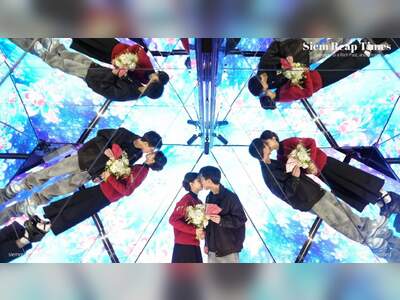The Ukrainian Sumo Wrestler Who Escaped the War — and Is Captivating Japan
At only twenty-one, Arata Aunishiki has risen from refugee to one of Japan’s top sumo contenders, earning a historic tournament victory and a likely promotion to the sport’s second-highest rank.
He arrived in Japan with nothing, unable to speak the language but carrying a single, determined dream — to become a professional sumo wrestler.
At the age of twenty-one, with the support of a Japanese coach who took him in, Arata Aunishiki has climbed to the second-highest level in the sport.
And he has no intention of stopping.
“It doesn’t surprise me that I reached this point,” he said.
Aunishiki won the Kyushu Grand Tournament after defeating Mongolia’s grand champion Hoshoryu in a tiebreaker — one of only two wrestlers in Japan who currently hold sumo’s highest rank.
“I’m happy I managed to compete at my highest level,” he told viewers watching on television and the crowd inside Fukuoka Kokusai Center.
“And I’m happy I fulfilled one of my dreams”.
Following the victory, Japan’s Sumo Association will meet to promote him to the rank of Ozeki, just below Yokozuna, the grand champion.
His ascent has been meteoric, almost unprecedented — but that alone is not what makes his story remarkable.
Aunishiki was born twenty-one years ago in Vinnytsia, Ukraine, eight-thousand-five-hundred kilometers from where he celebrated his triumph.
Arata is his ring name; he was born Danilo Yavosyshyn.
Standing one-point-eight meters tall and weighing one-hundred-thirty kilograms, Yavosyshyn was not destined for muddy battlefields against Russian soldiers, but for the clean clay rings of sumo.
He and his family fled Ukraine after Russia’s violent invasion in February twenty-twenty-two.
They first escaped to Germany, but two months later he traveled alone to Japan to chase the dream he had carried since childhood.
He began practicing sumo at seven, became Ukraine’s national champion at seventeen, and competed in the Youth World Championships.
This was his path — no decree from Moscow was going to stop him.
He arrived in Japan with only a suitcase, no Japanese, and no financial support — a major hurdle in a country naturally cautious toward foreigners, especially in a national sport considered a source of deep pride.
Fortunately, he had met Japanese wrestler-coach Arata Yamanaka at the twenty-nineteen youth championships and stayed in touch.
“I had only met him once and didn’t speak a word of Japanese,” Yavosyshyn recalled.
“Still, he welcomed me warmly. If the situation were reversed, I’m not sure I would have agreed so easily”.
“I decided to host him and help him pursue his dream,” said Yamanaka, now twenty-five, who also trained him at a club in Kobe.
When Yavosyshyn entered the professional ranks in twenty-twenty-three, he became only the second Ukrainian in pro sumo, after Serhiy Sokolovsky, known in the ring as Shishi.
His recent tournament victory marked the first time a Ukrainian ever won a sumo competition in Japan.
By the time he won, Yavosyshyn — who adopted the ring name Arata as a tribute to his mentor — was already speaking fluent Japanese.
He dedicated the victory “to my big brother and my new family,” saying it was only the beginning of his journey.
At a press conference, he spoke of his longing for home and childhood friends, saying he has not returned to Ukraine since fleeing the war.
“I hope people in Ukraine can watch my matches or read about them so they can escape reality for a moment — or so I can give some hope to children and young people in a country where hope is hard to find right now”.
Although most professional wrestlers are Japanese, and others typically come from across Asia, Ukraine has a strong amateur tradition in sumo, rooted in the nation’s deep wrestling and judo culture.
The Japanese public embraced him warmly.
He learned the language, respected the culture, and honored the sport through discipline, talent, and fierce competitiveness.
His rapid rise is the fastest in modern sumo history — reaching the top division within a year and now approaching promotion to Ozeki.
Another reason the Japanese crowd admires him is the creativity of his fighting style.
His victories often come through inventive techniques.
He now begins a new chapter: the pursuit of becoming the first European in history to reach the rank of grand champion.
“I’ve always had the biggest dreams for how far I could go in sumo,” he said.
“I’m not surprised by where I am today, but I have to admit I surprised myself with how quickly it happened”.
“I don’t plan too far ahead. There’s a long road in front of me, with many difficult moments, and that’s the point. When you grow up in a place like Ukraine, you learn not to plan too far into the future. There are too many things you can’t control, and everything can turn upside down overnight”.
At the age of twenty-one, with the support of a Japanese coach who took him in, Arata Aunishiki has climbed to the second-highest level in the sport.
And he has no intention of stopping.
“It doesn’t surprise me that I reached this point,” he said.
Aunishiki won the Kyushu Grand Tournament after defeating Mongolia’s grand champion Hoshoryu in a tiebreaker — one of only two wrestlers in Japan who currently hold sumo’s highest rank.
“I’m happy I managed to compete at my highest level,” he told viewers watching on television and the crowd inside Fukuoka Kokusai Center.
“And I’m happy I fulfilled one of my dreams”.
Following the victory, Japan’s Sumo Association will meet to promote him to the rank of Ozeki, just below Yokozuna, the grand champion.
His ascent has been meteoric, almost unprecedented — but that alone is not what makes his story remarkable.
Aunishiki was born twenty-one years ago in Vinnytsia, Ukraine, eight-thousand-five-hundred kilometers from where he celebrated his triumph.
Arata is his ring name; he was born Danilo Yavosyshyn.
Standing one-point-eight meters tall and weighing one-hundred-thirty kilograms, Yavosyshyn was not destined for muddy battlefields against Russian soldiers, but for the clean clay rings of sumo.
He and his family fled Ukraine after Russia’s violent invasion in February twenty-twenty-two.
They first escaped to Germany, but two months later he traveled alone to Japan to chase the dream he had carried since childhood.
He began practicing sumo at seven, became Ukraine’s national champion at seventeen, and competed in the Youth World Championships.
This was his path — no decree from Moscow was going to stop him.
He arrived in Japan with only a suitcase, no Japanese, and no financial support — a major hurdle in a country naturally cautious toward foreigners, especially in a national sport considered a source of deep pride.
Fortunately, he had met Japanese wrestler-coach Arata Yamanaka at the twenty-nineteen youth championships and stayed in touch.
“I had only met him once and didn’t speak a word of Japanese,” Yavosyshyn recalled.
“Still, he welcomed me warmly. If the situation were reversed, I’m not sure I would have agreed so easily”.
“I decided to host him and help him pursue his dream,” said Yamanaka, now twenty-five, who also trained him at a club in Kobe.
When Yavosyshyn entered the professional ranks in twenty-twenty-three, he became only the second Ukrainian in pro sumo, after Serhiy Sokolovsky, known in the ring as Shishi.
His recent tournament victory marked the first time a Ukrainian ever won a sumo competition in Japan.
By the time he won, Yavosyshyn — who adopted the ring name Arata as a tribute to his mentor — was already speaking fluent Japanese.
He dedicated the victory “to my big brother and my new family,” saying it was only the beginning of his journey.
At a press conference, he spoke of his longing for home and childhood friends, saying he has not returned to Ukraine since fleeing the war.
“I hope people in Ukraine can watch my matches or read about them so they can escape reality for a moment — or so I can give some hope to children and young people in a country where hope is hard to find right now”.
Although most professional wrestlers are Japanese, and others typically come from across Asia, Ukraine has a strong amateur tradition in sumo, rooted in the nation’s deep wrestling and judo culture.
The Japanese public embraced him warmly.
He learned the language, respected the culture, and honored the sport through discipline, talent, and fierce competitiveness.
His rapid rise is the fastest in modern sumo history — reaching the top division within a year and now approaching promotion to Ozeki.
Another reason the Japanese crowd admires him is the creativity of his fighting style.
His victories often come through inventive techniques.
He now begins a new chapter: the pursuit of becoming the first European in history to reach the rank of grand champion.
“I’ve always had the biggest dreams for how far I could go in sumo,” he said.
“I’m not surprised by where I am today, but I have to admit I surprised myself with how quickly it happened”.
“I don’t plan too far ahead. There’s a long road in front of me, with many difficult moments, and that’s the point. When you grow up in a place like Ukraine, you learn not to plan too far into the future. There are too many things you can’t control, and everything can turn upside down overnight”.









